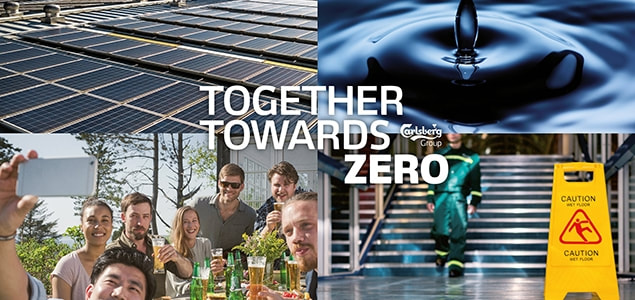|
Image Credit: Carlsberg Carlsberg Group has pledged to eliminate carbon emissions and halve water usage at its breweries worldwide by 2030, as part of a new sustainability drive, launched in June 2017. The beer maker also intends to switch to 100 percent renewable electricity for its breweries by 2022, as one of several intermediate goals. The ‘Together Towards Zero’ programme has been a year in the making and is consciously aligned with the UN Sustainable Development Goals. As well as carbon and water, the programme – which is an integral part of Carlsberg’s Sail '22 strategy – is also targeting significantly reduced health and safety impacts due to irresponsible drinking and accidents. Carlsberg has adopted a phased approach here to ensure that any momentum is maintained. By 2022, it hopes to achieve 50 percent reduction in brewery carbon emissions and to have eliminated the use of coal at its factories. It is also targeting a 15 percent reduction in ‘beer-in-hand’ (Scope 3 emissions) carbon footprint by the same date, working in partnership with 30 suppliers. Asked to assess the scale of challenge that lies ahead, Carlsberg’s sustainability director, Simon Hoffmeyer Boas, told Sustainable Brands: “If you ask any business to decarbonise completely, it will be a huge task.” He added that it will signal a new wave of innovation for the brewer: “It will require changes in the way we buy our products, in the way we produce our beer and the machinery we use for that.” Given that packaging materials account for the majority of Carlsberg’s carbon footprint (around 40 percent), the company will look to work more closely with key packaging suppliers to find solutions to drive those impacts down. Hoffmeyer Boas also points to the use of on-site renewables to increase efficiencies. Carlsberg’s Dali brewery in China, for instance, has installed over 8,000 rooftop solar panels to help mitigate annual CO2 emissions of more than 1,800 tonnes; the energy generated from these panels is meeting roughly 20 percent of the brewery’s electricity needs. On water, the beer maker aims to reduce brewery water use by 25 percent by 2022, before looking to double that reduction by 2030. It will also work with partners to improve water management in high-risk areas around selected breweries. “This is a very difficult target to reach, but we are confident that it’s the right thing to do, to set out on this direction,” Hoffmeyer Boas said. “We have done some analysis with WWF that shows that 15 of our sites in Asia are sited in areas that might have water scarcity risks in the future.” Carlsberg is already looking to get its water-to-beer ratios down. As of 2015, Hoffmeyer Boas says the company’s average ratio stands at 3.4 litres of water per litre of beer. The intention is to reduce that figure to 2.7 litres by 2022, and then to 1.7 litres by 2030. And for those breweries sited in high-risk areas of water scarcity, the company will look to go even further – exploring the potential to go below a 2.0 ratio by 2022. Like many other leading beer brands, Carlsberg is keen to highlight the issue of responsible drinking, to prevent misuse of alcohol and associated behaviours such as drunk driving and underage drinking. New targets in this area include offering 100 percent distribution of alcohol-free beer by 2022 to expand consumer choice and forming new partnerships to encourage responsible consumption. Hoffmeyer Boas considers valued judgements around alcohol consumption to be a crucial part of the sustainability mix. “To me, sustainability is all about going above and beyond legislation. So if we undertake a massive effort in responsible drinking to prevent people from misusing our products, we are going beyond what is generally expected of us as a company”. In order to achieve its new set of goals, Carlsberg acknowledges the need for a deeper level of staff engagement. It plans to run a comprehensive internal campaign, encouraging employees to come up with their own ideas of how to work towards zero – this might be at an operational level, or through sharing best practice. Importantly, it will be linked to performance. “There’s no doubt that Together Towards Zero will be integrated into KPIs across the business, and that’s an ongoing process,” Hoffmeyer Boas said. “As you can imagine there’s a lot of work being put into calculations and roadmaps, so we’re still defining exactly how. But we have a CEO who has explicitly requested that this is done.” Ultimately, Hoffmeyer Boas hopes the new programme will not only demonstrate how Carlsberg is responding to increasing consumer demand for more sustainable products, but also build greater resilience into the company’s supply chain going forward. “We believe that we are de-risking our operation and also opening ourselves up to much more opportunity and innovative ways of doing things. I’m not saying this will be a walk in the park … but we are drawing a line in the sand and saying this is the company we want to be.”
1 Comment
|
WANT TO PUBLISH AN ARTICLE HERE?
Have a read at our Publishing Guidelines: NEWSLETTER
Subscribe to our newsletter to get the sustainability articles sent to you every month. EDITOR
Lauren Guido |
|
Follow Us
Contact Us
|
Want to learn more? |


